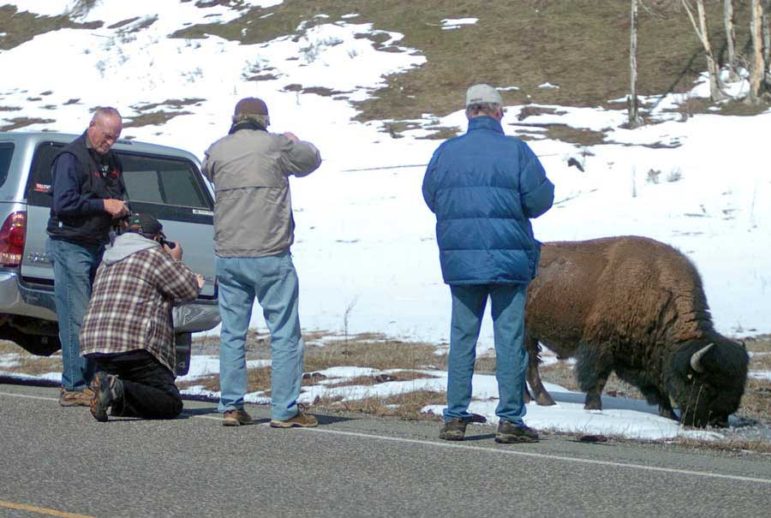
Visitors to Yellowstone National Park risk injury when allowing bison or other wildlife to approach within 25 yards, as photographers are seen doing in this file photo.
A 62-year-old Australian man sustained serious injuries Tuesday morning after an encounter with a bison near Old Faithful Lodge in Yellowstone National Park.
The man, whose name was not released by park authorities, is the second visitor in less than three weeks to suffer a serious injury after a close encounter with a bison near Old Faithful geyser.
While it is not uncommon for park visitors to be injured by bison or other wildlife, officials from Yellowstone and Grand Teton national parks have commented recently about what they say is a growing challenge in educating international visitors about the danger of wild animals.
According to information released by the park’s public affairs office about Tuesday’s incident, witnesses reported that several people were crowding around a bison that was lying on the grass near a paved footpath.
The man approached the bison while taking pictures with a tablet. When he had moved to within five feet, the animal charged, tossing the man into the air several times.
When responding rangers arrived on scene, the bison was approximately 100 yards from the victim. The victim was transported by ambulance and then taken by helicopter for further medical treatment. Park authorities reported that the man’s injuries were not considered life-threatening, but additional details were not immediately available.
Last month, a 16-year-old Taiwanese exchange student was injured by a bison while visiting the Upper Geyser Basin with her host family. While hiking near Old Faithful Geyser, the family joined a group of people watching a bison grazing adjacent to the trail.
Witnesses to last month’s incident reported that the girl was within about five feet of the bison when she turned her back to the animal to have her picture taken.
During a March interview conducted before either of the recent bison incidents, outgoing Yellowstone spokesman Al Nash discussed “the ongoing issue we have in helping visitors understand that (Yellowstone’s) wild animals are truly wild, and that they are visiting a wild environment.”
“I frankly wonder if our challenges in that area aren’t getting greater over time now, simply because visitors today have less experience with wild, large animals than visitors may have had 30 years go,” Nash said.
Visitors to Yellowstone and Grand Teton are from increasingly urban and international population bases, making it more difficult—but even more important—for managers to convey critical safety information about wildlife and the hazards of a wild environment.
During a May visit to Cody for National Parks Day, Grand Teton Superintendent David Vela said the National Park Service is increasingly looking for new ways to connect with international tourists and younger visitors.
One option is a platform of smartphone apps that can convey information about any national park unit, while Grand Teton has created its own Chinese-language print magazine that offers key safety tips for first-time visitors, he said.
But bison injuries are likely to remain among the most common sources of serious injuries in Yellowstone.
Bison can sprint three times faster than humans can run, and are unpredictable and dangerous. And with 3.5 million annual visitors spreading out across Yellowstone’s 2.2. million acres to view and photograph up to 5,000 bison, the odds are high that more such incidents are likely—or even inevitable.
Contact Ruffin Prevost at 307-213-9818 or ruffin@yellowstonegate.com.

When are people going to learn that animals in the parks are NOT tame???? It would seem to me to be obvious, but I guess not!